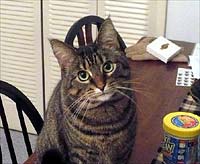|
|
Bailey's Case Study
|
next story >> |
 Other Diseases/Conditions:
Other Diseases/Conditions:
none
Story: In October, 2010, I noticed that Bailey was sneezing on a more frequent basis. I did not think that there was anything to be too concerned about, as I have another cat who suffers from seasonal allergies and sneezing is nothing new in my home. All of a sudden, in mid-November, Bailey began having sneezing attacks which would last 3-5 minutes at a time and occur nearly every hour. At the same time, she started to bleed from her nose. I immediately took her to the vet.
Initially, the vet thought that Bailey had a severe respiratory infection and told me not to be concerned. She had a fever and after an injection of antibiotic, she bounced right back. Over Thanksgiving, a week after my first vet visit, Bailey all of a sudden went down hill again. She would not eat or drink and hid under the bed. A return visit to the vet resulted in Xrays and blood work. Everything was normal, she was negative for FIV, so we switched to liquid antibiotics with syringe food and water. We believed that she was not eating because of nasal discharge impacting her ability to smell.
After another week of no improvement, we visited a specialist who performed additional Xrays and a rhinoscopy. The specialist believed that there was a nasal polyp, but because of the placement, an additional rhinoscopy was scheduled to allow a different scope with better placement to remove the polyp. After the rhinoscopy, Bailey was placed on prednisolone and seemed to be essentially back to normal. No discharge or sneezing and was eating me out of house and home.
 On December 14, the second rhinoscopy was performed. We fully expected the polyp to be removed and continue life as usual. Unfortunately, with the new scope, when the polyp-like structure was removed it revealed a larger mass and when the biopsy was performed, there were bone fragments in the sample. The vet indicated that this was possibly a fungal infection or a tumor.
On December 14, the second rhinoscopy was performed. We fully expected the polyp to be removed and continue life as usual. Unfortunately, with the new scope, when the polyp-like structure was removed it revealed a larger mass and when the biopsy was performed, there were bone fragments in the sample. The vet indicated that this was possibly a fungal infection or a tumor.
While we waited for the biopsy results Bailey was pretty much back to normal. With daily prednisolone therapy, a very low dose, she was running around, playing, eating, drinking, and acting like the same old Bailey. Unfortunately, on December 21, 2010, the biopsy confirmed lymphoma.
I cannot bring myself to treat with chemotherapy or radiation when, as a cat, she cannot tell me what hurts and how to make her feel better. Like many other owners, and after watching my mother go through radiation therapy, I believe that a month of high quality life is better than a maximum of six months going through therapy. Bailey is terrified of cars and takes two days to recover from a typical wellness check at the vet. If she did not respond to cars and vet visits in such a traumatic way, perhaps I would think differently.
I have made peace with knowing that the decision to treat or keep her comfortable in her last weeks is not the determination of whether I am a good owner. Each owner must make the best decision for their pet based on their particular circumstances and prognosis.
Bailey's future involves one final Christmas filled with catnip, cat treats, and ice cream (which she begs for whenever I have some). She will receive prednisolone therapy to keep her comfortable as long as possible. At that time, I'll have to make the painful choice to let her go to happy hunting grounds.
Bailey was rescued from a shelter just prior to being put down when she was almost two. My only hope is that she has lived five fantastic years with me and that when her quality of life fades, that I will rescue her from this terrible illness the same way that I rescued her from the shelter.
My heart goes out to every owner who has to make these terrible decisions for their pet. My hope is that they know how much they are loved.
Outcome: Updated January 20, 2011 - Bailey had been doing very well, with no symptoms on the Prednisolone therapy. On January 16 she developed nasal discharge. I took her to the vet on January 18, where the vet relayed that the discharge (which had now developed an odor) was a result of necrotic tissue around the nasal tumor and I decided to let her go to chase the bunnies in the sky. Though I did not have as much time with her as the vet had anticipated, her quality of life was fantastic until January 16th, with no signs of discomfort and the energy and playfulness of a kitten.
Outcome: Treating with prednisolone to maintain comfort.
- By Kate Bailey's Mom - |
|
next story >> |
|
|
Photos
Chemo Protocol Used
Holistic Remedies Used
| |

